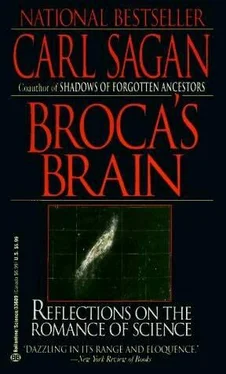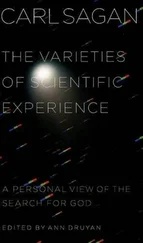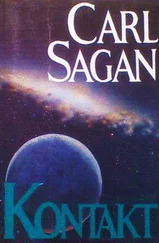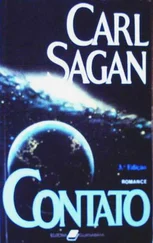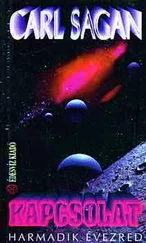Carl Sagan - Broca's Brain - The Romance of Science
Здесь есть возможность читать онлайн «Carl Sagan - Broca's Brain - The Romance of Science» весь текст электронной книги совершенно бесплатно (целиком полную версию без сокращений). В некоторых случаях можно слушать аудио, скачать через торрент в формате fb2 и присутствует краткое содержание. Жанр: Физика, на английском языке. Описание произведения, (предисловие) а так же отзывы посетителей доступны на портале библиотеки ЛибКат.
- Название:Broca's Brain: The Romance of Science
- Автор:
- Жанр:
- Год:неизвестен
- ISBN:нет данных
- Рейтинг книги:3 / 5. Голосов: 1
-
Избранное:Добавить в избранное
- Отзывы:
-
Ваша оценка:
- 60
- 1
- 2
- 3
- 4
- 5
Broca's Brain: The Romance of Science: краткое содержание, описание и аннотация
Предлагаем к чтению аннотацию, описание, краткое содержание или предисловие (зависит от того, что написал сам автор книги «Broca's Brain: The Romance of Science»). Если вы не нашли необходимую информацию о книге — напишите в комментариях, мы постараемся отыскать её.
Broca's Brain: The Romance of Science — читать онлайн бесплатно полную книгу (весь текст) целиком
Ниже представлен текст книги, разбитый по страницам. Система сохранения места последней прочитанной страницы, позволяет с удобством читать онлайн бесплатно книгу «Broca's Brain: The Romance of Science», без необходимости каждый раз заново искать на чём Вы остановились. Поставьте закладку, и сможете в любой момент перейти на страницу, на которой закончили чтение.
Интервал:
Закладка:
A second astonishing development was inaugurated in 1971 when D. A. Allen of Cambridge University and T. L. Murdock of the University of Minnesota found that the observed infrared emission from Titan at a wavelength of 10 to 14 microns is more than twice what is expected from solar heating. Titan is too small to have a significant internal energy source like Jupiter or Saturn. The only explanation seemed to be the greenhouse effect in which the surface temperature rises until the infrared radiation trickling out just balances the absorbed visible radiation coming in. It is the greenhouse effect that keeps the surface temperature of the Earth above freezing and the temperature of Venus at 480°C.
But what could cause a Titanian greenhouse effect? It is unlikely to be carbon dioxide and water vapor as on Earth and Venus, because these gases should be largely frozen out on Titan. I have calculated that a few hundred millibars of hydrogen (1,000 millibars is the total sea-level atmospheric pressure on Earth) would provide an adequate greenhouse effect. Since this is more than the amount of hydrogen observed, the clouds would have to be opaque at certain short wavelengths and more nearly transparent at certain longer wavelengths. James Pollack, at NASA’s Ames Research Center, has calculated that a few hundred millibars of methane might also be adequate and, moreover, might explain some of the details of the infrared emission spectrum of Titan. This large amount of methane would also have to hide under the clouds. Both greenhouse models have the virtue of invoking only gases thought to exist on Titan; of course, both gases might play a role.
An alternative model of the Titan atmosphere was proposed by the late Robert Danielson and his colleagues at Princeton University. They suggest that small quantities of simple hydrocarbons-such as ethane, ethylene and acetylene-which have been observed in the upper atmosphere of Titan absorb ultraviolet light from the Sun and heat the upper atmosphere. It is then the hot upper atmosphere and not the surface that we see in the infrared. On this model there need be no enigmatically warm surface, no greenhouse effect, and no atmospheric pressure of hundreds of millibars.
Which view is correct? At the present time no one knows. The situation is reminiscent of studies of Venus in the early 1960s when the planet’s radio-brightness temperature was known to be high, but whether the emission was from a hot surface or a hot region of the atmosphere was (appropriately) hotly debated. Since radio waves pass through all but the densest atmospheres and clouds, the Titan problem might be resolved if we had a reliable measure of the radio-brightness temperature of the satellite. The first such measurement was performed by Frank Briggs of Cornell with the giant interferometer of the National Radio Astronomy Observatory in Green Bank, West Virginia. Briggs finds a surface temperature of Titan of −140°C with an uncertainty of 45°. The temperature in the absence of a greenhouse effect is expected to be about −185°C. Briggs’s observations therefore seem to suggest a fairly sizable greenhouse effect and a dense atmosphere, but the probable error of the measurements is still so large as to permit the zero greenhouse case.
Subsequent observations by two other radio astronomical groups give values both higher and lower than Briggs’s results. The higher range of temperatures, astonishingly, even approaches temperatures in cold regions of the Earth. The observational situation, like the atmosphere of Titan, seems very murky. The problem could be resolved if we could measure the size of the solid surface of Titan by radar (optical measurements give us the distance from cloudtop to cloudtop). The problem may have to await studies by the Voyager mission, which is scheduled to send two sophisticated spacecraft by Titan-one very close to it-in 1981.
Whichever model we select is consistent with the red clouds. But what are they made of? If we take an atmosphere of methane and hydrogen and supply energy to it, we will make a range of organic compounds, both simple hydrocarbons (like the sort that are needed to make Danielson’s inversion layer in the upper atmosphere) and complex ones. In our laboratory at Cornell, Bishun Khare and I have simulated the kinds of atmospheres that exist in the outer solar system. The complex organic molecules we synthesize in them have optical properties similar to those of the Titanian clouds. We think there is strong evidence for abundant organic compounds on Titan, both simple gases in the atmosphere and more complex organics in the clouds and on the surface.
One problem with an extensive Titanian atmosphere is that the light gas hydrogen should be gushing away because of the low gravity. The only way that I can explain this situation is that the hydrogen is in a “steady state.” That is, it escapes but is replenished from some internal source-volcanoes, most likely. The density of Titan is so low that its interior must be almost entirely composed of ices. We can think of it as a giant comet made of methane, ammonia and water ices. There must also be a small admixture of radioactive elements which, while decaying, will heat their surroundings. The heat conduction problem has been worked out by John Lewis, of MIT, and it is clear that the near-surface interior of Titan will be slushy. Methane, ammonia and water vapor should be outgassed from the interior and broken down by ultraviolet sunlight, producing atmospheric hydrogen and cloud organic compounds at the same time. There may be surface volcanoes made of ice instead of rock, spewing out in occasional eruptions not liquid rock but liquid ice-a lava of running methane, ammonia and perhaps water.
There is another consequence of the escape of all this hydrogen. An atmospheric molecule that achieves escape velocity from Titan generally does not have escape velocity from Saturn. Thus, as Thomas McDonough and the late Neil Brice of Cornell have pointed out, the hydrogen that is being lost from Titan will form a diffuse toroid, or doughnut, of hydrogen gas around Saturn. This is a very interesting prediction, first made for Titan but possibly relevant for other satellites as well. Pioneer 10 has detected such a hydrogen toroid around Jupiter in the vicinity of Io. As Pioneer 11 and Voyager 1 and 2 fly near Titan, they may be able to detect the Titan toroid.
Titan will be the easiest object to explore in the outer solar system. Nearly atmosphereless worlds such as Io or the asteroids present a landing problem because we cannot use atmospheric braking. Giant worlds such as Jupiter and Saturn have the opposite problem: the acceleration due to gravity is so large and the increase in atmospheric density is so rapid that it is difficult to devise an atmospheric probe that will not burn up on entry. Titan, however, has a dense enough atmosphere and a low enough gravity. If it were a little closer, we probably would be launching entry probes there today.
Titan is a lovely, baffling and instructive world which we suddenly realize is accessible for exploration: by fly-bys to determine the gross global parameters and to search for breaks in the clouds; by entry probes to sample the red clouds and unknown atmosphere; and by landers to examine a surface like none we know. Titan provides a remarkable opportunity to study the kinds of organic chemistry that on Earth may have led to the origin of life. Despite the low temperatures, it is by no means impossible that there is a Titanian biology. The geology of the surface may be unique in all the solar system. Titan is waiting…
CHAPTER 14

Is it not the height of silent humour
Интервал:
Закладка:
Похожие книги на «Broca's Brain: The Romance of Science»
Представляем Вашему вниманию похожие книги на «Broca's Brain: The Romance of Science» списком для выбора. Мы отобрали схожую по названию и смыслу литературу в надежде предоставить читателям больше вариантов отыскать новые, интересные, ещё непрочитанные произведения.
Обсуждение, отзывы о книге «Broca's Brain: The Romance of Science» и просто собственные мнения читателей. Оставьте ваши комментарии, напишите, что Вы думаете о произведении, его смысле или главных героях. Укажите что конкретно понравилось, а что нет, и почему Вы так считаете.
